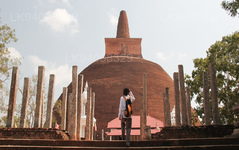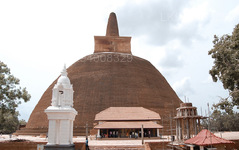
Anuradhapura-stad
Anuradhapura behoort tot de Noord-Centrale Provincie van Sri Lanka. Anuradhapura is een van de oude hoofdsteden van Sri Lanka, beroemd om zijn goed bewaard gebleven ruïnes van de oude Lankaanse beschaving. De stad, nu UNESCO-werelderfgoed, ligt 205 km ten noorden van de huidige hoofdstad Colombo in Sri Lanka.
Abhayagiri Dagoba
Abhayagiri Vihāra was a major monastery site of Mahayana, Theravada and Vajrayana Buddhism that was situated in Anuradhapura, Sri Lanka. It is one of the most extensive ruins in the world and one of the most sacred Buddhist pilgrimage cities in the nation. Historically it was a great monastic centre as well as a royal capital, with magnificent monasteries rising to many stories, roofed with gilt bronze or tiles of burnt clay glazed in brilliant colors. To the north of the city, encircled by great walls and containing elaborate bathing ponds, carved balustrades and moonstones, stood "Abhayagiri", one of seventeen such religious units in Anuradhapura and the largest of its five major viharas. One of the focal points of the complex is an ancient stupa, the Abhayagiri Dagaba. Surrounding the humped dagaba, Abhayagiri Vihara was a seat of the Northern Monastery, or Uttara Vihara and the original custodian of the Tooth relic in the island.
The term "Abhayagiri Vihara" refers not only to the complex of monastic buildings, but also a fraternity of Buddhist monks, or Sangha, which maintained its own historical records, traditions and way of life. Founded in the 2nd century BC, it had grown into an international institution by the 1st century AD, attracting scholars from all over the world and encompassing all shades of Buddhist philosophy. Its influence can be traced to other parts of the world, through branches established elsewhere. Thus, the Abhayagiri Vihara developed as a great institution vis‑a‑vis the Mahavihara and the Jetavana Buddhist monastic sects in the ancient Sri Lankan capital of Anuradhapura.
It is recorded in the chronicle that Abhayagiri Dagaba was established by King Valagamba during the period of his second reign, from 89-77 B.C.E. A young Brahmin named Tiya (Tissa) declared war against him. Tiya was deluded by the prophecy of another Brahmin that was destined to be king. Before the arrival of Bhikkhu Mahinda, who brought Buddhism to the island, Brahmins held the highest place in society. After the establishment of the Buddhist sangha on the island, however, they lost their supremacy, and were replaced by the sangha. Some Brahmins converted to Buddhism, while others revolted. Tiya, who enjoyed the support of his community, lived both in and outside of Sri Lanka, and was therefore very powerful.
Over het district Anuradhapura
Anuradhapura behoort tot de Noord-Centrale Provincie van Sri Lanka. Anuradhapura is een van de oude hoofdsteden van Sri Lanka, beroemd om zijn goed bewaard gebleven ruïnes van de oude Lankaanse beschaving. De stad, nu een UNESCO-werelderfgoed, ligt 205 km ten noorden van de huidige hoofdstad Colombo in Sri Lanka. In de heilige stad Anuradhapura en de omgeving bevinden zich een groot aantal ruïnes. De ruïnes bestaan uit drie soorten gebouwen: dagoba's, kloostergebouwen en pokuna (vijvers). De stad had enkele van de meest complexe irrigatiesystemen uit de oudheid, gelegen in de droge zone van het land. De overheid bouwde vele tanks om het land te irrigeren. De meeste burgers zijn Singalees, terwijl Tamils en Sri Lankaanse Moren in het district wonen.
Over Noord-Centrale Provincie
Noord-Centrale Provincie, de grootste provincie van het land, beslaat 16% van het totale landoppervlak van het land. De Noord-Centrale Provincie bestaat uit twee districten genaamd Polonnaruwa en Anuradhapure. Anuradhapura is het grootste district in Sri Lanka. Het gebied is 7.128 km². De Noord-Centrale Provincie heeft talloze mogelijkheden voor investeerders om hun bedrijven te starten, met name landbouw, agrarische industrieën en veeteelt. Meer dan 65% van de mensen van de Noord-Centrale Provincie is afhankelijk van basislandbouw en agrarische basisindustrieën. NCP wordt ook wel "Wew Bendi Rajje" genoemd omdat er meer dan 3.000 middelgrote en grote tanks in de provincie zijn gelegen. Sri Maha Bodiya, Ruwanweli Seya, Thuparama Dageba, Abayagiri-klooster, Polonnaruwa Rankot Wehera, Lankathilake zijn bang














